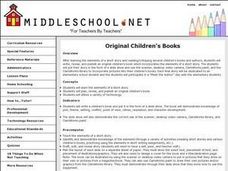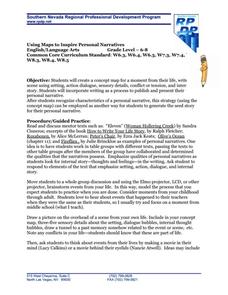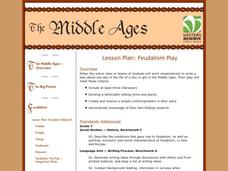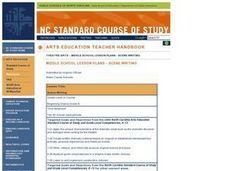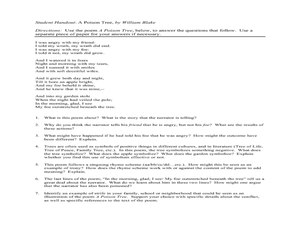Curated OER
Plot Summary for Story Elements
Ninth graders identify story elements utilizing a plot summary organizer. In this plot summary activity, 9th graders discuss the elements of a good story and listen to the story of the three little pigs. Students complete a group plot...
Nazareth College
Cooperation and Conflict Resolution
Fourth graders participate in a variety of activities designed to promote cooperation and positive conflict resolution. In cooperative groups, they create a comic strip or poster, play cooperative musical chairs, write a journal entry...
Curated OER
Teaching a Short Story
Students work in small groups and prepare an analysis of a short story to be presented to their peers. They research the story and create a handout or a visual aid that cites sources of information and summarizes the main points of the...
Curated OER
Story Webbing: Tennessee Blueprint
In this Tennessee Blueprint worksheet, 6th graders complete a story web for Tennessee Blueprint including setting, characters, point of view, and more. Students complete 9 sections.
Curated OER
Camels: Creative Writing
For this writing worksheet, learners plan and write a story with a plot involving a camel. Students include a setting, characters, conflict, three main events and a conclusion.
Curated OER
The World Around Me
Combining visual and language arts, here is a resource that prompts middle schoolers to write stories based on pictures of their surroundings. They use digital cameras to take pictures of favorite areas in the school. Next, they choose...
Curated OER
Prince Ibrahima
Sixth graders read and utilize the facts from the story "Abd al-Rahmen Ibrahima" by Walter Dean Myers to analyze the main character's life which is ruined by conflict, jealousy, and greed. Journal entries are created in response to the...
PB Works
The Cay by Theodore Taylor
Record the plot elements of The Cay on this learning exercise. Pupils note basic information about the book and answer questions about the introduction, point of view, character, conflict, rising action, climax, falling action, and...
Curated OER
Drama from Animal Characters
Learn about animal habitats, characteristics, and writing in a different perspective. The class composes a narrative from the perspective of a fresh water animal, they include a problem and the animal's reaction to the problem. The...
Curated OER
Original Children's Books
Bring the fun and creativity of children's stories to your language arts class. Middle schoolers write, revise, and publish an original student book which incorporates the elements of a short story. They put their story in the form of a...
Curated OER
Fairy Tales Retold
Students use writing processes effectively to adapt and retell stories. They reread a favorite fairy tale, then adapt and retell in a PowerPoint or other multimedia presentation. They present their rewritten and edited presentations to...
Southern Nevada Regional Professional Development Program
Using Maps to Inspire Personal Narratives
A solid description of one way to teach narrative writing, this resource outlines the writing process from concept to completion. Class members create concept maps of moments in their lives and follow the writing process to publish their...
Curated OER
Narrative Nuts and Bolts
After viewing slides and reading about child labor, young authors compose an original narrative story. They practice note-taking skills and work to effectively engage a reader by incorporating plot, logical order, complex characters,...
Curated OER
Language Arts: Plot Summary
Eighth graders implement plot summary organizers to identify essential elements such as conflict and resolution in literature. In pairs, they retell fairy tales to each other and complete plot summaries about them. As students read new...
Freeology
Summarizing
Scholars draft a summary using a graphic organizer featuring a story's characters, setting, main events, conflict, and resolution.
EngageNY
Grade 10 ELA Module 1: Unit 2, Lesson 6
Is history "little more than a relic," as one of the characters in "The Palace Thief" contends? Has Hundert's love of antiquity kept him from changing with the times? Readers consider how the author uses these conflicting views to...
Northeastern Educational Television of Ohio, Inc.
Feudalism Play
Using research notes on feudal roles in medieval Europe, learners work cooperatively to write a play about one day in the life of a boy or girl in the Middle Ages.
Curated OER
Write an Easter Story
In this Easter story worksheet, students use the story element format to help them form a plan for their Easter story. Students write about the setting, characters, conflict, and conclusion.
Curated OER
Identifying the Solution in a Story
Using the book My Red Balloon by Eve Bunting, Kindergartners will gain an understanding that stories often have solutions. Using Eve Bunting's book as an example the teacher will identify the solution to the story and...
Curated OER
Conflict
Students outline the action in their narrative writing assignments by brainstorming about conflict. In this conflict analysis lesson, students define conflict and discuss the different types of conflict. Students brainstorm about a...
Curated OER
The Great Kapok Tree- Teaching About Conflict in Literature
Students identify the plot of a text. In this literature lesson, students listen to the book The Great Kapok Tree and identify the problem and solution. A graphic organizer is used to help reinforce the concept.
Curated OER
Scene Writing
Eighth graders create an original scene or short one-act play within specified guidelines. Assessment is based upon the performance of student-created scenes during class time. Rubrics for assessment and connection to state standards...
Curated OER
"Tree of Peace": Critical Thinking About Revolution to Global Conflict
Tenth graders explore the importance of peace in society. In this Global History lesson plan, 10th graders create a common vocabulary for the different elements that exist in a peaceful society. Students discover the...
Curated OER
Writing Short Stories Using a Plot Diagram
Students read Abe Lincoln's Hat and use a plot diagram to identify the sequence of the story. They use plot diagrams to write their own stories from the perspective of Abraham Lincoln's hat.









